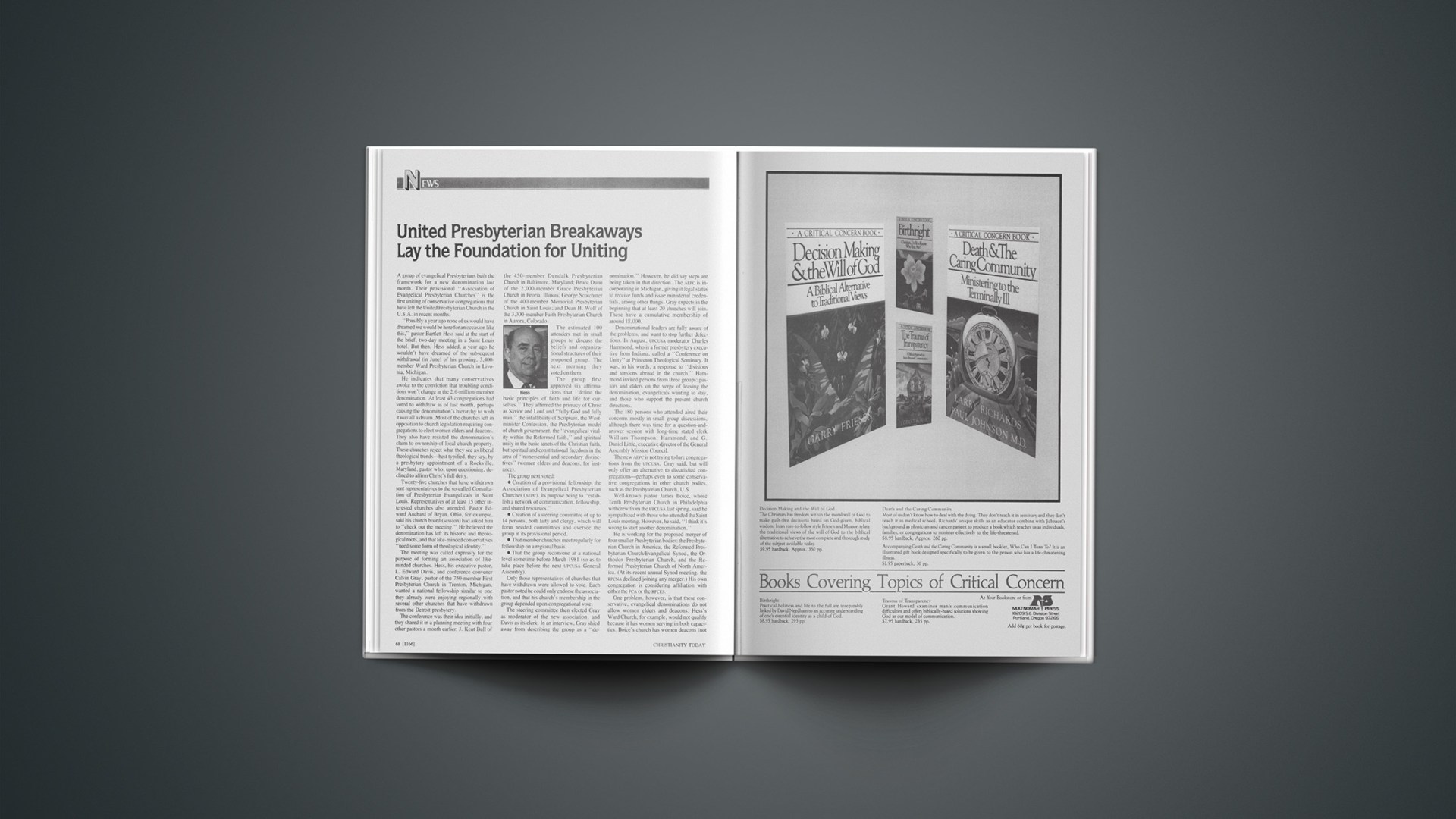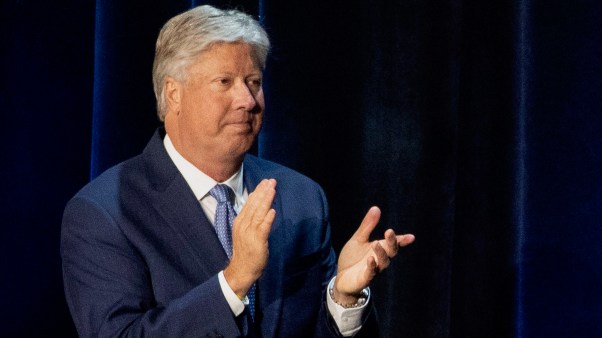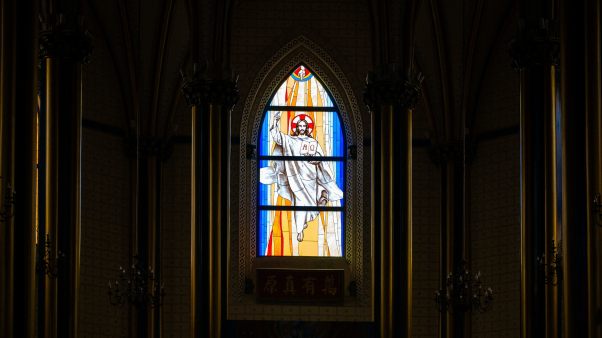A group of evangelical Presbyterians built the framework for a new denomination last month. Their provisional “Association of Evangelical Presbyterian Churches” is the first uniting of conservative congregations that have left the United Presbyterian Church in the U.S.A. in recent months.
“Possibly a year ago none of us would have dreamed we would be here for an occasion like this,” pastor Bartlett Hess said at the start of the brief, two-day meeting in a Saint Louis hotel. But then, Hess added, a year ago he wouldn’t have dreamed of the subsequent withdrawal (in June) of his growing. 3,400-member Ward Presbyterian Church in Livonia, Michigan.
He indicates that many conservatives awoke to the conviction that troubling conditions won’t change in the 2.6-million-member denomination. At least 43 congregations had voted to withdraw as of last month, perhaps causing the denomination’s hierarchy to wish it was all a dream. Most of the churches left in opposition to church legislation requiring congregations to elect women elders and deacons. They also have resisted the denomination’s claim to ownership of local church property. These churches reject what they see as liberal theological trends—best typified, they say, by a presbytery appointment of a Rockville, Maryland, pastor who, upon questioning, declined to affirm Christ’s full deity.
Twenty-five churches that have withdrawn sent representatives to the so-called Consultation of Presbyterian Evangelicals in Saint Louis. Representatives of at least 15 other interested churches also attended. Pastor Edward Auchard of Bryan, Ohio, for example, said his church board (session) had asked him to “check out the meeting.” He believed the denomination has left its historic and theological roots, and that like-minded conservatives “need some form of theological identity.”
The meeting was called expressly for the purpose of forming an association of like-minded churches. Hess, his executive pastor, L. Edward Davis, and conference convener Calvin Gray, pastor of the 750-member First Presbyterian Church in Trenton, Michigan, wanted a national fellowship similar to one they already were enjoying regionally with several other churches that have withdrawn from the Detroit presbytery.
The conference was their idea initially, and they shared it in a planning meeting with four other pastors a month earlier: J. Kent Bull of the 450-member Dundalk Presbyterian Church in Baltimore, Maryland; Bruce Dunn of the 2,000-member Grace Presbyterian Church in Peoria, Illinois; George Scotchmer of the 400-member Memorial Presbyterian Church in Saint Louis; and Dean H. Wolf of the 3,300-member Faith Presbyterian Church in Aurora, Colorado.
The estimated 100 attenders met in small groups to discuss the beliefs and organizational structures of their proposed group. The next morning they voted on them.
The group first approved six affirmations that “define the basic principles of faith and life for ourselves.” They affirmed the primacy of Christ as Savior and Lord and “fully God and fully man,” the infallibility of Scripture, the Westminister Confession, the Presbyterian model of church government, the “evangelical vitality within the Reformed faith,” and spiritual unity in the basic tenets of the Christian faith, but spiritual and constitutional freedom in the area of “nonessential and secondary distinctives” (women elders and deacons, for instance).
The group next voted:
• Creation of a provisional fellowship, the Association of Evangelical Presbyterian Churches (AEPC), its purpose being to “establish a network of communication, fellowship, and shared resources.”
• Creation of a steering committee of up to 14 persons, both laity and clergy, which will form needed committees and oversee the group in its provisional period.
• That member churches meet regularly for fellowship on a regional basis.
• That the group reconvene at a national level sometime before March 1981 (so as to take place before the next UPCUSA General Assembly).
Only those representatives of churches that have withdrawn were allowed to vote. Each pastor noted he could only endorse the association, and that his church’s membership in the group depended upon congregational vote.
The steering committee then elected Gray as moderator of the new association, and Davis as its clerk. In an interview, Gray shied away from describing the group as a “denomination.” However, he did say steps are being taken in that direction. The AEPC is incorporating in Michigan, giving it legal status to receive funds and issue ministerial credentials, among other things. Gray expects in the beginning that at least 20 churches will join. These have a cumulative membership of around 18,000.
Denominational leaders are fully aware of the problems, and want to stop further defections. In August, UPCUSA moderator Charles Hammond, who is a former presbytery executive from Indiana, called a “Conference on Unity” at Princeton Theological Seminary. It was, in his words, a response to “divisions and tensions abroad in the church.” Hammond invited persons from three groups: pastors and elders on the verge of leaving the denomination, evangelicals wanting to stay, and those who support the present church directions.
The 180 persons who attended aired their concerns mostly in small group discussions, although there was time for a question-and-answer session with long-time stated clerk William Thompson, Hammond, and G. Daniel Little, executive director of the General Assembly Mission Council.
The new AEPC is not trying to lure congregations from the UPCUSA, Gray said, but will only offer an alternative to dissatisfied congregations—perhaps even to some conservative congregations in other church bodies, such as the Presbyterian Church, U.S.
Well-known pastor James Boice, whose Tenth Presbyterian Church in Philadelphia withdrew from the UPCUSA last spring, said he sympathized with those who attended the Saint Louis meeting. However, he said, “I think it’s wrong to start another denomination.”
He is working for the proposed merger of four smaller Presbyterian bodies: the Presbyterian Church in America, the Reformed Presbyterian Church/Evangelical Synod, the Orthodox Presbyterian Church, and the Reformed Presbyterian Church of North America. (At its recent annual Synod meeting, the RPCNA declined joining any merger.) His own congregation is considering affiliation with either the PCA or the RPCES.
One problem, however, is that these conservative, evangelical denominations do not allow women elders and deacons: Hess’s Ward Church, for example, would not qualify because it has women serving in both capacities. Boice’s church has women deacons (not women elders), but he suggests his church might get around this barrier by creating a separate board of deaconesses. He suggested that Hess and others also look for alternatives that would allow them to join an existing Presbyterian body.
(The one-year-old group of pastors who oppose having women officers, Concerned United Presbyterians, for the most part has stopped functioning. The group lost most of its leaders [Boice and Dunn, for instance], after their churches withdrew from the UPCUSA.)
Some UPCUSA evangelical groups, such as Presbyterians United for Biblical Concerns, remain in support of bringing renewal from within the denomination. The PUBC and evangelical groups within the PCUS believe a long-anticipated merger of these two largest Presbyterian denominations would result in a single, more conservative and evangelical body. They point out that UPCUSA stated clerk Thompson expects an end to the legislation requiring women elders and deacons in a merged group, and that he has predicted accomplishment of the merger by 1985.
Gordon-Conwell Seminary professor Richard Lovelace, a well-known advocate of evangelicals staying in the UPCUSA, sent a memo to Gray and Hess before the Saint Louis meeting asking that they consider formation of a “relief presbytery,” similar to that organized in the 1840s by Scottish churchman Thomas Gillespie. Such a group would maintain a relationship with the parent church, and return when certain conditions of reunion are met.
In an interview, Hess said the newly formed AEPC can be explained no other way than as “the work of the Holy Spirit.” He said the Holy Spirit is “building his church through separations, as well as through those who feel compelled to stay within the church.”
Hess said he still hopes to see renewal within the UPCUSA, and rejects criticisms of being “schismatic”: all Presbyterians have roots in some form of separation—the sixteenth-century Protestant Reformation being the example common to all, he said, if anything, he noted, recent church withdrawals have “done more to shake up the church [UPCUSA] than all of our talk had done … there have been more sermons preached on the deity of Christ in the last couple of months than there have ever been.”
JOHN MAUST
Is The Sanctuary Safe?
Certain United Presbyterian congregations are leaving their denomination on principle, but they would prefer that it be with their church property as well.
Many of these congregations have gone to court over the matter, because the presbyteries are holding to the denomination’s claim to ownership of all local church property. These cases were in various stages of litigation around the country last month, but no decisions had been made.
In fact, there have been no major church property rulings since two recent U.S. Supreme Court actions that favored the property claims of the local congregation. In Jones v. Wolf, the court indicated that property should go to the withdrawing majority of the congregation when the denomination does not have specific claim to it in its constitution.
To close this loophole, the UPCUSA General Assembly adopted a constitutional amendment in June making explicit its “implied trust” concept, which says local church property is held in trust for the denomination as a whole. Final ratification of the amendment by the next assembly probably would take away the legal claims to property by most withdrawing congregations. Some churches have thus decided to get out while they still have a chance of keeping the pews they’re sitting on.
One of the few experts on church property issues is editor G. Aiken Taylor of the independent Presbyterian Journal. The ordained Presbyterian Church in America (PCA) minister attended the Saint Louis meeting of Presbyterian evangelicals as the invited PCA representative and chairman of its interchurch relations committee (see related story). He spoke on church property issues when a number of those in attendance at Saint Louis sought his advice during an informal supper meeting.
“Right now, the denomination is probing for soft spots; they are looking for the weaker cases that would establish the first precedent,” he said. He noted that each case is different.
Taylor advised the group to find lawyers knowledgeable in this fledgling field, or at least to find ones “willing to listen” and learn. At least three lawyers, who are representing churches that have withdrawn, attended the Saint Louis meeting in order to get an update on recent property disputes (and, no doubt, some new clients).
UPCUSA associate stated clerk Robert Stevenson has been given the responsibility for monitoring the church withdrawal situation for the denomination. He asserted that the U.S. Supreme Court had interfered with the church’s interpretation of its own constitution.
Presbyteries are responsible for their own legal proceedings in property disputes, he said, while adding that most “are generally following the book” in upholding the denomination’s claim to property. “We’re [the denomination] hoping to get some clear-cut decisions this fall,” he said.
There has been maneuvering by the withdrawing churches and the presbyteries. Some presbyteries have requested the membership rolls of withdrawing congregations; Taylor said these have contacted members who might not have voted for the church’s withdrawal, and who would be willing to file suit for the property as a continuing congregation.
Some congregations have placed their funds in separate corporations that can’t be touched. Some have offered to buy their property. But in most instances, any solutions will require a court’s consideration.
“Whoever wins the next one or two cases is going to make a great, big splash,” Taylor said.
Personalities: The Bob Green and
Anita Bryant Breakup: Picking Up the Pieces
With the dust from her divorce beginning to settle, people wondering whether Anita Bryant plans to resume her public life will have to keep wondering. She hasn’t decided yet, says her agent, Jackie Lee.
Several weeks ago Bryant moved from Florida back to her home town of Tulsa, Oklahoma. She is renting a house in Tulsa, and three of her four children are with her. Her oldest son, Bob, 17, remained in Florida with her former husband, Bob Green.
Bryant is filling a number of singing engagements made before the divorce, such as one for a trucking company convention in Staunton, Virginia, early in September, at which she sang secular and patriotic songs, and at sacred music concerts in Nashville and Clewiston, Florida.
“It’s just too soon,” said Lee. “She just put the kids in school, and she still has crates to unpack.” Lee said singing dates have been falling off ever since Bryant stepped into the middle of the fight to repeal a Dade County (Miami), Florida, ordinance prohibiting discrimination against homosexuals.
A crusader against family breakup, as well as against homosexuality, the singer shocked many when she filed for divorce last May. She revealed then that the two had been separated “in heart, mind, and body” for much of their 20-year marriage.
A friend of Bryant in Miami said the singer is “waiting for God to heal the hurt and waiting for him to show her what to do. She holds herself responsible for the disappointment many people feel.”
Green, who managed Bryant’s career as head of Anita Bryant Ministries, has renamed the organization “Successful Life Ministries”; it still deals primarily in seminars and counseling. He said, “The top priority in my life is to win Anita back.” The two haven’t spoken lately, he said.
Green said his own experience qualifies him more than ever to teach people how to avoid divorce, although he himself doesn’t lead the seminars.
Green also has formed a new organization called Crusade for Morality. It is designed to help out Christian groups who get involved in local morality disputes—with homosexual organizations, for instance—and need experienced, outside advice, such as on strategy, and dealing with the public media. He’s already been advising a Baptist pastor in Virginia Beach who organized a referendum vote in November over whether the city libraries should remove copies of a local homosexual newspaper. Green also hopes to do battle against the liberal American Civil Liberties Union and the lawsuits it frequently files that bear on morality issues.
TOM MINNERY
Museum, school, research center …
Graham Center Provides Evangelism Focal Point
The new Billy Graham Center reaches up five floors, each one about the size of a football field. The 193,000-square-foot, Colonial-style structure—from its eight molded, fiber glass pillars to its rooftop cupola—appears almost awkwardly huge compared to other buildings on the Wheaton (Ill.) College campus.
But then, college officials believe the center’s contribution to Christendom will be just as conspicuous. They say its museum, library, and archives offer the largest collection of materials on missions and evangelism anywhere in the world, and that it will become a training center and a think tank for world evangelization.
The center opened officially last month with a dedication ceremony and a series of programs designed to display the facilities to a curious local public, college alumni, and area news reporters.
In his dedicatory address, Graham described the history of the center. Looking north toward the college’s Blanchard Hall, where he attended many classes prior to his 1943 Wheaton College graduation, Graham said the original intent six years ago had been to find a home for his personal records and those of the Billy Graham Evangelistic Association (BGEA). Plans expanded beyond a library, however. The 61-year-old evangelist felt “God wanted it [the center] to be more than a place to house these things,” but also a center for research and planning in missions and evangelism.
Several other schools had wanted the center, including Southern Baptist Theological Seminary in Louisville, Kentucky, and the University of North Carolina (Graham’s home state). Graham said. However he chose Wheaton for several reasons: his ties to the school (he and his wife are trustees); the city is a hub of evangelicalism; and because of the undergraduate and graduate schools’ emphases on world missions and social concern.
Graham got applause after saying the $13.5 million structure was all paid for. It is a gift from the BGEA to Wheaton College with “no strings attached,” he said, and will become a department of the college under the management of the school’s trustees board. Former president of Holiday Inns, Bill Walton, took an early retirement in order to raise (within 18 months, it is hoped) a $15 million endowment, which will earn the $1 million necessary for annual operations costs. No student fees or tuition will go to support the center.
Critics had seen the center as a multimillion-dollar monument to a single man. And some Wheaton College faculty have feared the center will detract from, and place a drain on, the 120-year-old school’s respected four-year, liberal arts programs.
Mindful of those concerns in his dedicatory address, Graham said the building would be used for God’s glory, not his own. He told reporters that his own preference had been that the center not even carry his name. The center’s director, William A. Shoemaker, said original plans for the center were revamped midway after Graham felt certain exhibits were too gawdy and overemphasized himself.
The center’s research facilities will be available to anyone. The library has 60,000 bound volumes, and another 80,000 in micro form.
Materials in the archives record interdenominational Protestant evangelism and missions in America. Beginning five years ago with the records of Graham and the BGEA, the archives have grown to include 197 collections (any materials except books, serials, and artifacts). Its files include personal letters of John Wesley, D.L. Moody, and Ira Sankey, taped interviews with missionaries, records of the Africa Inland Mission from 1902 to 1978, three boxes of material on evangelist Billy Sunday, and all manner of slides, videotapes and cassettes, diaries, scrapbooks, and other collectable paraphernalia.
The general public learns the history of Christianity, and particularly that of evangelism in America, in the first floor museum. Displays and headphone recordings describe various evangelists and movements, and ministries of the BGEA. There is a “walk through the gospel,” with salvation messages etched on the walls, and special effects to represent Christ’s crucifixion and resurrection.
The second floor of the center is home for the 425-student Wheaton Graduate School, with its four emphases in psychological studies, communications, theology, and Christian ministries. The fifth floor is vacant, pending decisions on its use.
School officials intend to bring key international Christian leaders to the center for short-term training, and to offer schools of evangelism for pastors and laity. They say they will address major issues facing evangelicals in forums with prominent evangelical spokesmen, similar to the three-day “Forum on the Church’s Future,” held prior to the Saturday, September 13, dedication. The center also will finance various missions projects: already earmarked is a manual for first-term missionaries, and a leadership program for worldwide ministry for Chinese Christian students in the U.S.
About 6,000 persons attended the outdoor dedication ceremony. Most of these were local residents, although prominent guests included President Jimmy Carter’s religious liaison, Robert Maddox, and Barbara Bush (described by Graham as a long-time personal friend), wife of Republican vice-presidential candidate George Bush. While most of the addresses were as sunny as the September 13 skies, keynote speaker Charles Malik, the former president (from Lebanon) of the United Nations General Assembly, warned of a crippling, spiritual darkness at universities in Europe and America. Christians and Christian schools must work harder if they are to match the academic and intellectual prowess of their secular counterparts; they must train the moral, responsible leaders that the universities are not training, he said. Next in importance to saving souls is saving minds, he said.
Appropriately, Graham ended his Wheaton visit with a Sunday evening evangelistic rally, participated in by 248 west suburban Chicago churches. Despite his “churched” audience—many of whom work for the more than 30 Christian organizations located in the area—Graham preached his usual salvation message. However, he noted that just living in Wheaton or a nearby suburb doesn’t ensure one’s personal salvation. Of the 10,000 attenders, about 330 responded to Graham’s call for Christian commitment; about 100 made first-time decisions.
Among the attenders was Richard Brandel, vice-president of the J. Emil Anderson Company in Des Plaines, Illinois, the contractor for the center. As the building superintendent of the center in 1978, Brandel became a Christian under the influence of a Wheaton College employee, Warren Schilling. Prior to his work at the site, Brandel said he had been “seeking after God,” and that he had encountered Schilling at just the right time. Graham Center officials hope the center’s impact will be just as decisive and timely.
JOHN MAUST
Personalia
Two years after becoming a Christian, British actor James Fox gave up his career in 1971 to work with other Christians. For the last six years he has been associated with the Navigators, and leading a student group at Leeds University in England. Now, he says, he plans to return to acting, in a British television series planned for next year, believing the Lord wants him to use his acting talents again. Fox played in Thoroughly Modern Millie, Those Magnificent Men in Their Flying Machines, and King Rat.
At its international convocation in Birmingham, England, Youth for Christ International elected Jim Groen in August to succeed Sam Wolgemuth as president and chairman of the board. Jim Wilson, a Canadian, was elected general director, succeeding Groen in that post. The internationalized administration was frustrated in efforts to name a Third World leader as chairman, but is committed to seeing that happen four years from now.










